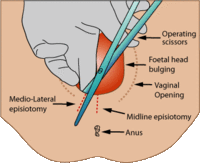
Photo from wikipedia
Abstract Rationale, aims, and objectives The aim of this study was to focus attention on episiotomy practice in Romanian maternity units in order to identify factors associated with the very… Click to show full abstract
Abstract Rationale, aims, and objectives The aim of this study was to focus attention on episiotomy practice in Romanian maternity units in order to identify factors associated with the very high rate of the procedure in Romania and to consider strategies to reduce it. Methods In this clustered cross‐sectional study, a total of 11 863 patients were recorded in eight Romanian maternity units to assess the prevalence of episiotomy. A random effects Poisson model was used to estimate the prevalence rate in univariate and multivariate models. Results Among the 11 863 patients included for analysis, 8475 (71.4%) had an episiotomy. The prevalence of episiotomy was 92.7% for the first vaginal birth, 73.2% for the second vaginal birth, and 35% for the third vaginal birth. The overall rate of suturing was higher than the episiotomy rate for all patients (total rate 79.2%). The likelihood of exiting the maternity ward with an intact perineum after the first vaginal birth was less than 5% at the first vaginal birth. Conclusions In conclusion, routine episiotomy is the norm in Romanian maternity units, with episiotomy rates among the highest in Europe. Episiotomy use is mainly driven by local professional norms, experiences, previous training, and practitioners' decisions rather than evidence, guidelines, or variations in patient needs at the time of vaginal birth.
Journal Title: Journal of Evaluation in Clinical Practice
Year Published: 2019
Link to full text (if available)
Share on Social Media: Sign Up to like & get
recommendations!